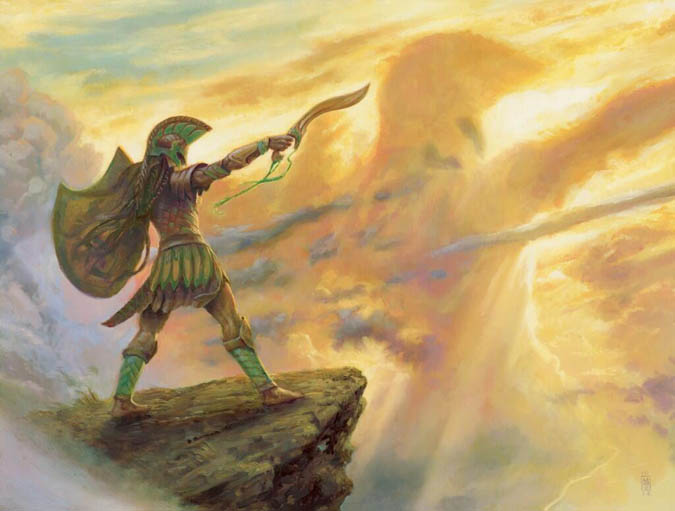Theros just dropped some preview art at Comic-Con and PAX Australia, and we have much to discuss.
I'm an art history graduate, and I studying more than my share of classical and neoclassical art, despite studying late medieval art as much as possible. Visually, we will only see about five percent of the possible influence that this range of styles can bring us. Let us compare 1200 BCE through 476 CE and the 1800s of "Classical and the revival of classicism" to just "gothic horror." The well is way deeper in one instance. That's exciting because we can return in the future; it's not disappointing because it might not be thorough enough.
Invariably, you've seen MaRo's blog-post note on Theros.
The highlights revealed at the panel:
- It is to Greek mythology what Innistrad was to gothic horror
- Top-down design
- First time I lead the design and Erik Lauer led the development since Innistrad
- the block has an enchantment theme somehow connected to the gods
- The set has gods, heroes and monsters. Each has a new mechanic tied to it
- Of the other two mechanics, one is a repeated mechanic brought back that strongly hits the flavor of Greek mythology; the second is a mechanic that we thought had potential but didn't live up to it first time out - it has been mechanically retweaked and given a new name and flavor. The last mechanics is also tied to the gods
- There will be more legendary permanents than normal - not Kamigawa but above average
- The set's tone is one of accomplishment and adventure
- Not a lot of tribal but minotaurs get some love
- Many nods to elements of the stories of Greek myth
- 3 planeswalkers - Elspeth and two new ones
- A few gold cards but mostly monocolored with a little monocolored theme
- A Future Sight card and the set does something we've never done before except on another Future Sight card.
There's so much data in there, and we still haven't fully downloaded M14 yet. That's an ambitious overload of information, Wizards. I like it. Read it again.
For you art/storyline fans, the Vorthos folk, we need a primer on Greek mythology, but we haven't the time. What we can do is talk about the art--namely, what classical and neoclassical art is--some things to look for, and some expectations using the previewed art as a roadmap. This set, according to MaRo "is to Greek mythology what Innistrad was to gothic horror." I see some classicism, yes, but more so, I see neoclassicism, the lens by which most Americans see Greek and Roman art.
What Is Neoclassicism?
- In ideals, it is a return to perceived purity of ancient Greece and republic of Rome that happened in the late 1700s and throughout the 1800s, predominantly in what is now the United State of America.
- Works of all kinds, whether it's art, literature, or politics, will model the ideals of the classical time, the ancient Greek and Roman culture, and also some 16th-century Renaissance beliefs. It's not a universally "antique" belief system.
- Conviction runs through it, saying there are universals that embody truths about what things are and should be in the world. These universals can be rediscovered and relearned in the collected wisdom of classical authors, poets, and artists. Think of how Plato described culture as a good example.
- Classical ethics create a foundation for political and cultural aspirations of Americans looking to create a nation built upon universal, ideal truths. Think of how life, liberty, and the pursuit of happiness came into being from John Locke looking to classical ideals.
Look at the above words: purity, ideal, universals, and ethics. Each has been hammered home in civics classes to the three required Citizenship in the Community, Nation, and World merit badges. These elements--aspects really--were not only influential in the founding of America, but began the wheel that changed art forever and why we have this postmodernism business.
Why Does This Start Seemingly Randomly in the 1700s?
An excavator Rocque Joaquin de Alcubierre is partially responsible for finding the origins of the neoclassical style. He rediscovered the buried Roman cities of Herculaneum and Pompeii, the latter having been buried by the eruption of Mt. Vesuvius of course. He found them in 1738 and 1748, respectively. When you find preserved remains of surprised Pompeii citizens covered in hardened ash, it sure does spur an interest in antiquity:

Seated Man, photo by Science Museum of Minnesota
In addition, Johann Joachim Winckelmann was a German archaeologist and philosopher who wrote his seminal work Gedanken Łber die Nachahmung der griechischen Werke in der Malerei und Bildhauerkunst--or Reflections on the Painting and Sculpture of the Greeks--in 1755. (He lived 1717-1768.) His views were that Greek art showed ideal imagined forms, moving to a more beautiful and perfected nature.

You don't think White Goodman understood idealization? It's why he used the style as well. It sure takes on a little different meaning in context below, doesn't it?
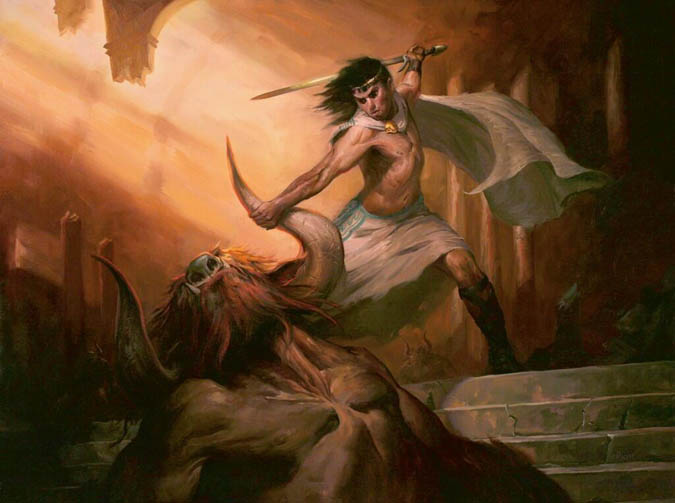
Still very, very nice. More on contrapposto soon.
This belief that Greek stuff, art especially, was the ideal, the best, started a shit-storm of academic controversy whether he was right. From the discussion, Roman art took a center stage whether it was a diluted Greek form. By doing this, it spurred interest in Greek architecture, art, politics and popular thought. It was the Kim Kardashian of news--except for smart people.
Is It as Though the United State in the 1800s Was Looking for Perfection?
Yes, it's basically 'Merica 101, if you will.
In essence, the founding fathers deconstructed the Roman government (a republic) in a political self-interest in the process creating a modern democratic republic. The Greeks and Romans had debated and developed the principles of justice, the rule of law, liberty, and due process. For the founders, tyranny, monarchy, and aristocracy provided very visceral illustrations of heroism, as did classical advocates of the philosophical life of a higher order.
This neoclassical, and especially American, view of the classical world was to admire the workings of republican government, not imperialism, unrestrained democratic rule, or at worst, monarchy. Political leaders were looking for keys to successful and longstanding government that protected citizens against tyranny.

Founding Fathers, copyright Irrational Games
It's basically like Bioshock Infinite, except weirdly wrong and evil.
What About the Art?
During this time, not just the Americans were looking into neoclassicism. They loved it, but a ton of other countries left an array of paintings, sculptures, buildings, and furniture freighted with inventive and sometimes radical forms. (Mannerism was an early precedent actually.) Neoclassicism would also be standardized. It's also the biggest detriment because people see modern-day churches and museums as boring, white marble with busts of forgotten soldiers, politicians, and those who wanted to be remembered but had no reason to be memorable. This is the tip of the iceberg, the random doodle on the wall that people think represents all "post-modern" art. Don't let architecture be a placeholder for the style.
I ran track in college, and as I was in a division-one NCAA school, we traveled a lot. (Minnesota isn't perfect for track weather all the time.) Before races, earlier in the day to calm my nerves, I used to walk around campuses, checking out their art museums (often tiny) or their public art, such as statues. You wouldn't believe how many classical depictions are on your local school's grounds.
Theros: Things to Watch out For
I'm always about dropping Easter eggs--hints on things to come--and deconstruct from the art. Magic has rules that need to be followed. Style guides are created with guidelines that produce roughly similar cards and depictions. Think of a creature with trample or a counterspell--how does the illustration, in our tightly-knit, top-down design process need to fit that art description? With a strong Greek mythology base, well, we have enough clues to catch Carmen Sandiego before the first commercial break.
These are things to look for, from the most obvious to the more nuanced and subtle. Check them:
Hero's Journey
This will come up a lot in the prerelease and launch party activities. If you are unaware of what this means, immediately watch these two videos below because you, as a Magic player, don't have the time to read Joseph Campbell's book and film on the subject. (But you should; it's knowledge after all.)
This will come up constantly‚ÄČ.‚ÄČ.‚ÄČ.‚ÄČso make sure they're doing it correctly. I've seen my share of punts in other games trying to use it right.
If you know already, you can watch them later.
Mythological Monsters
MaRo announced it, and, well, duh. We will see Centaurs, Hydras, Krakens, Medusae, Minotaurs, and Satyrs, among the resonant things that will be frickin' everywhere. That's cool that we're using established creatures with backstories--allowing for new players to immediately get it and jump in--compared to explaining what a baloth is.
I hope there are a ton more. I'm certain Sirens won't be in there due to creative team member Doug Beyer's blog post. I do love flavorful Sirens; they are very nice.
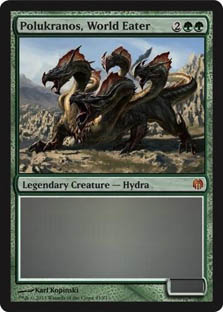
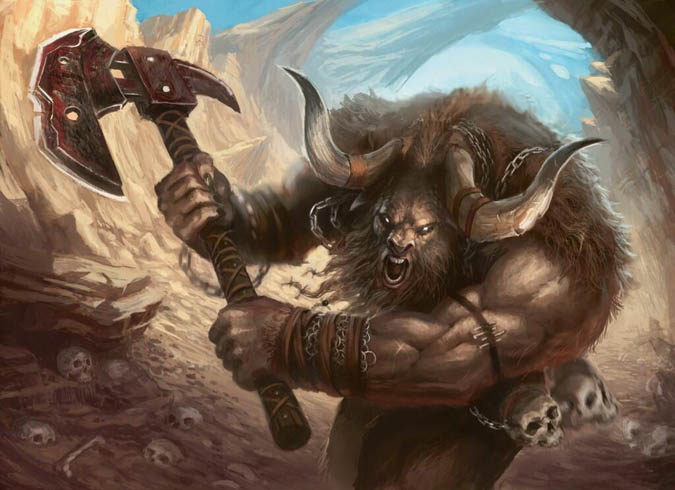
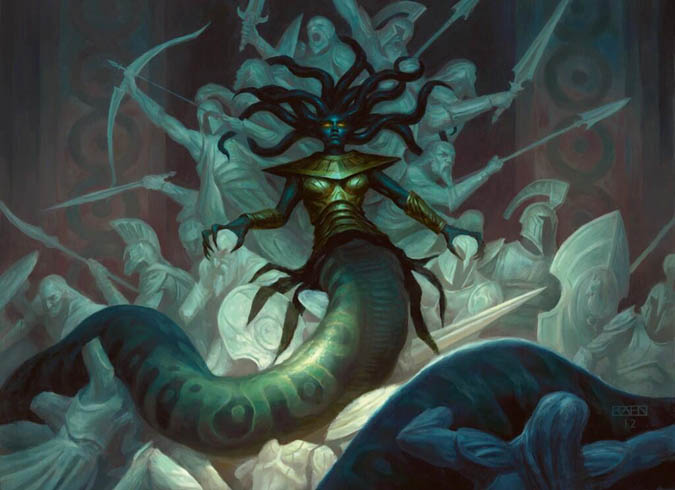
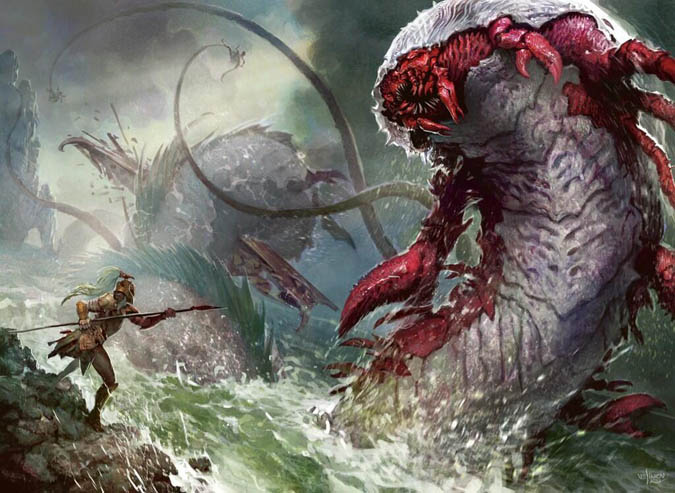
Bonus!
Clint Cearley just randomly added this image quite recently to his portfolio. Is this a rejected Magic piece or one he thought up while working on a piece for Theros? Maybe. I'd expect Naiads to be in the block somewhere.
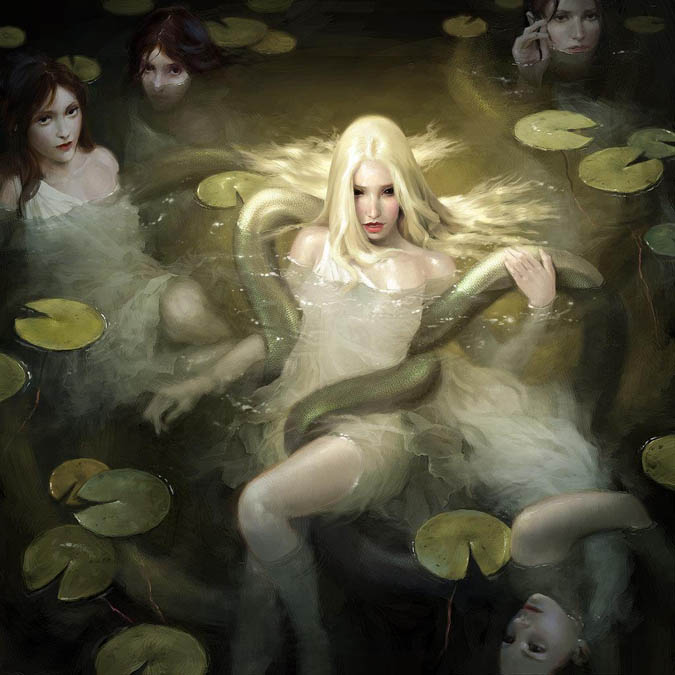
Contrapposto

Look for cards with the weight shift. It's a technique that shoes both dynamic movement and, with context, relaxed standing. If you see it, you'll know. Look for it earlier in this article with a minotaur battle. Check.
Death of the Father and Deicide, the Killing of a God
The God of War series covers these two concepts really well.
The killing of an avatar is a pretty important event, and yet, Magic hasn't really covered it in a flavorful way other than with Kamigawa and a few anecdotes. What does it mean to kill a god's physical form? Jesus, after all, was really just an avatar. It certainly creates a dynamic story when a god dies, or worse, when a god is created. Dungeons & Dragons covered this with its Vecna storyline.
Also in the panels, we heard that gods can take on multiple forms and walk amongst mortals. If they can be flesh and bone, they can die. Write that down.
Beautiful City-States
Unique cities are perfect Magic design. I hope Akros, Meletis, and Setessa appear to be a more streamlined and better designed than Innistrad's regions of Kessig, Nephalia, Stensia, and Thraben. While I grew up in the Black Forest of Germany and absolutely love Kessig, I didn't see much branding on it. It was a place, not a place that represents you as Ravnican guilds do. I could see Greek city-states create an Athens-versus-Sparta clash of ideals and worldviews and fit into Magic colors perfectly.
I just hope we see other views of them. While these concept images convey the emotion and location quite well, they appear to be pretty generic speed paints that art students and young professionals will stream from 11:00 P.M. through 2:00 A.M. most evenings. And perhaps that's the only reason for them: just to give you an emotion, a basis, for locations. I know Innistrad had them, and, of course, the style guide has loads of them.
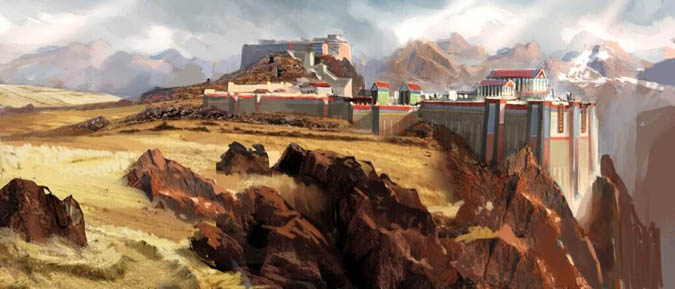
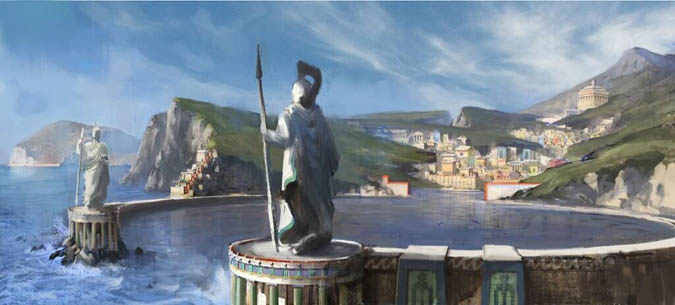
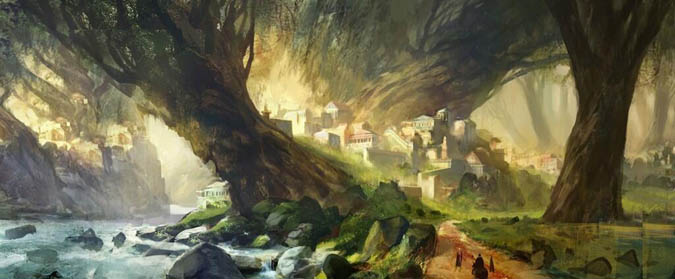
Idealized Musculature
Seeing male anatomy is nothing new or even novel, sure. What I'm excited to see is a woman's idealized form.

via Sports Illustrated‚ÄČ.‚ÄČ.‚ÄČ.‚ÄČStick with me here.
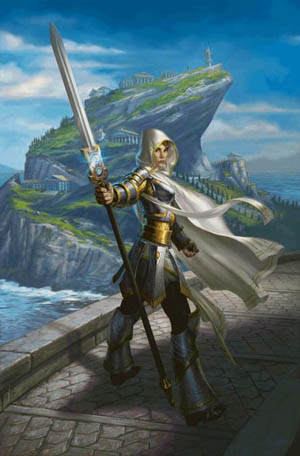 Greek ideals followed more of the Olympic ideal--not just mere 120-lb., 5'8" women with out-of-proportion breasts. I want to see the distance runner, the discus thrower, and everything in between. Perfect ideals exist in a variety of shape and sizes. I want serious pushing of the entire imaginative realism (Sci-Fi/Fantasy) art field forward. A woman in reasonable armor is great, as evidenced by M14, but that's nowhere near a silver bullet. It's representation, imperfection, and perfection shown in sets. Elspeth helps a lot, and she's the tip of the iceberg. Even in doing so, of course, she has the come-hither, over-the-shoulder look that is so ingrained in comic books that the Hawkeye Initiative was created. It's so close to being an epic, perfected, ideal pose. So close.
Greek ideals followed more of the Olympic ideal--not just mere 120-lb., 5'8" women with out-of-proportion breasts. I want to see the distance runner, the discus thrower, and everything in between. Perfect ideals exist in a variety of shape and sizes. I want serious pushing of the entire imaginative realism (Sci-Fi/Fantasy) art field forward. A woman in reasonable armor is great, as evidenced by M14, but that's nowhere near a silver bullet. It's representation, imperfection, and perfection shown in sets. Elspeth helps a lot, and she's the tip of the iceberg. Even in doing so, of course, she has the come-hither, over-the-shoulder look that is so ingrained in comic books that the Hawkeye Initiative was created. It's so close to being an epic, perfected, ideal pose. So close.

It's time we work on equity of images on everything, and this block is the perfect example to do so flavorfully.

via Sports Illustrated
And no, Michelangelo didn't have idealized forms. I'll cover more on that in a later article.
2D Works: Frescoes, Mosaics, Red/Black Pottery
We have seen some of this already with the Hero's Journey artwork. I love a good storytelling narrative using sequential art. Every medieval church doorway (portal) used this sequential style. Basically, they're comics. Sometimes, they're on a wall of a church, and other times, they're around a pot or in a rich person's home.
I hope we see some panoramas, some grandiose style-guide art that links together in strange and enlightening ways to tell us stories. Pottery was one option, as were walls nearly everywhere. If you've seen Donato's Archivist card, you'll see how the background can be immensely useful to push a narrative. That is a standalone card, but if you weave it into a greater image? Biscuits.
Check the below images and see how if they were a continuous image, as I mentioned Tyler Jacobson's image in M14 being in the Top 5 was.
It's a total missed opportunity to not have it be a continuous artwork as is one of the pieces I have on my own wall:

Milk Dud, a mini dachshund, for scale
Just look: Building a continuous frieze would've been incredible!
They'll be up on eBay very, very soon, and I guarantee they won't be cheap.
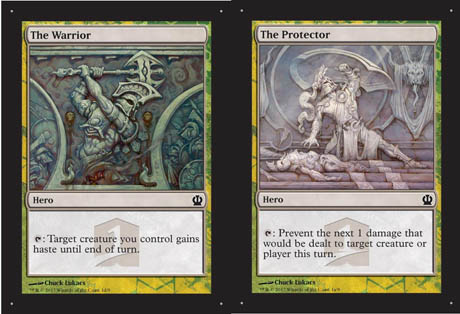
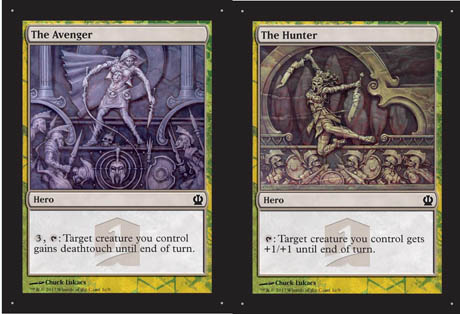
And last, before we go, here are some quick art predictions:
Legendary creature enchantments as godly powers -
Not just "enchantment matters". Game play needs to part of the set. Found a way to take enchantments and bring gods to life.
‚ÄĒ Magic: The Gathering (@wizards_magic) July 20, 2013
If a god's influence is real, showing it as an enchantment would be fantastic. It's influence, aid, or detriment to an area, which is exactly what divinity could reasonably do. Making enchantment lands, akin to places becoming real when a god is near, such as with the giant atop the beanstalk that Jack climbed or something of the like. It would be very visually appealing.
Grandeur is coming back - While I wish Magic would do an Indian block, showing different manifestations or avatars of the same god, it's very hard to do thus far. The mechanic of discarding godly powers or gifts by calling upon your god again, especially when they're already out, could make some fantastically flavorful stories and, more importantly, art depictions. It's hard to show more than a single representation, but there's always a way.
Big-time artists won't be used - It hurts me to say it, but the biggies in the illustration industry--the Donato Giancola, Michael Whelan, and the like--won't be visible in this block. To achieve the deeply neoclassical movement, musculature, and depth of the image, the standard Magic rate can't possibly cover these artists' going rates of commissions. I wish they took more on, but I understand.
Nudity and worse - If you've taken any classical history or art course, it's filled with sex-obsessed satyrs raping everything and shotgun weddings being the most PG of stories. It's how most minor or demigods came into being, really. As Magic is a roughly PG-13 game, I can't see it happening.
Onward with all the arts! I love the first depictions of the gods. They're fitting. I hope the obvious inclusion of a merfolk planeswalker turns out incredible because we know he and/or she is coming.
Best,
- Mike
















